Slip-Resistance Performance of Basketball Shoes Tread Patterns on Common Courts
Abstract
1. Introduction
2. Materials and Methods
2.1. Design and Development of Shoe Outsoles
2.2. Slip Testing Experiments
- σ = Standard deviation of ACOF
- X = The value in the data distribution
- µ = ACOF mean
- N = Five repetitions
3. Results
3.1. ACOF Outcomes on the Hardwood Flooring
3.2. ACOF Outcomes on the Synthetic Flooring
3.3. ACOF Outcomes on the PU Flooring
3.4. Impact of Footwear Characteristics on Traction Performance
3.4.1. Effect of Apparent Contact Area on ACOF
3.4.2. Effect of Heel Tread Pattern on ACOF
4. Discussion
5. Conclusions
Author Contributions
Funding
Institutional Review Board Statement
Informed Consent Statement
Data Availability Statement
Conflicts of Interest
References
- Stojanović, E.; Faude, O.; Scanlan, A.T.; Jakovljević, V.; Ćosić, M.; Kocić, M.; Radovanović, D. Injury incidence among adolescent and senior basketball players: A prospective study in 19 teams across an entire season. Phys. Sportsmed. 2024, 52, 386–394. [Google Scholar] [CrossRef] [PubMed]
- Narazaki, K.; Berg, K.; Stergiou, N.; Chen, B. Physiological demands of competitive basketball. Scand. J. Med. Sci. Sports 2009, 19, 425–432. [Google Scholar] [CrossRef] [PubMed]
- Kuhlman, S.; Sabick, M.; Pfeiffer, R.; Cooper, B.; Forhan, J. Effect of loading condition on the traction coefficient between shoes and artificial turf surfaces. Proc. Inst. Mech. Eng. Part P. J. Sport. Eng. Technol. 2010, 224, 155–165. [Google Scholar] [CrossRef]
- Borowski, L.A.; Yard, E.E.; Fields, S.K.; Comstock, R.D. The epidemiology of US high school basketball injuries, 2005–2007. Am. J. Sports Med. 2008, 36, 2328–2335. [Google Scholar] [CrossRef] [PubMed]
- Chang, W.-R.; Grönqvist, R.; Leclercq, S.; Myung, R.; Makkonen, L.; Strandberg, L.; Brungraber, R.J.; Mattke, U.; Thorpe, S.C. The role of friction in the measurement of slipperiness, Part 1: Friction mechanisms and definition of test conditions. Ergonomics 2001, 44, 1217–1232. [Google Scholar] [CrossRef] [PubMed]
- Hanson, J.P.; Redfern, M.S.; Mazumdar, M. Predicting slips and falls considering required and available friction. Ergonomics 1999, 42, 1619–1633. [Google Scholar] [CrossRef] [PubMed]
- Beschorner, K.E.; Redfern, M.S.; Porter, W.L.; Debski, R.E. Effects of slip testing parameters on measured coefficient of friction. Appl. Ergon. 2007, 38, 773–780. [Google Scholar] [CrossRef] [PubMed]
- Iraqi, A.; Cham, R.; Redfern, M.S.; Beschorner, K.E. Coefficient of friction testing parameters influence the prediction of human slips. Appl. Ergon. 2018, 70, 118–126. [Google Scholar] [CrossRef] [PubMed]
- Gupta, S.; Chatterjee, S.; Malviya, A.; Chanda, A. Traction Performance of Common Formal Footwear on Slippery Surfaces. Surfaces 2022, 5, 489–503. [Google Scholar] [CrossRef]
- Beschorner, K.E.; Chanda, A.; Moyer, B.E.; Reasinger, A.; Griffin, S.C.; Johnston, I.M. Validating the ability of a portable shoe-floor friction testing device, NextSTEPS, to predict human slips. Appl. Ergon. 2023, 106, 103854. [Google Scholar] [CrossRef] [PubMed]
- Aschan, C.; Hirvonen, M.; Mannelin, T.; Rajamäki, E. Development and validation of a novel portable slip simulator. Appl. Ergon. 2005, 36, 585–593. [Google Scholar] [CrossRef] [PubMed]
- Singh, G.; Beschorner, K.E. A Method for Measuring Fluid Pressures in the Shoe–Floor–Fluid Interface: Application to Shoe Tread Evaluation. IIE Trans. Occup. Ergon. Hum. Factors 2014, 2, 53–59. [Google Scholar] [CrossRef] [PubMed]
- Worobets, J.; Wannop, J.W. Influence of basketball shoe mass, outsole traction, and forefoot bending stiffness on three athletic movements. Sport. Biomech. 2015, 14, 351–360. [Google Scholar] [CrossRef] [PubMed]
- Moriyasu, K.; Nishiwaki, T.; Shibata, K.; Yamaguchi, T.; Hokkirigawa, K. Friction control of a resin foam/rubber laminated block material. Tribol. Int. 2019, 136, 548–555. [Google Scholar] [CrossRef]
- Lam, W.K.; Sterzing, T.; Cheung, J.T.M. Reliability of a basketball specific testing protocol for footwear fit and comfort perception. Footwear Sci. 2011, 3, 151–158. [Google Scholar] [CrossRef]
- Liu, H.; Wu, Z.; Lam, W.K. Collar height and heel counter-stiffness for ankle stability and athletic performance in basketball. Res. Sport. Med. 2017, 25, 209–218. [Google Scholar] [CrossRef] [PubMed]
- Yamaguchi, T.; Katsurashima, Y.; Hokkirigawa, K. Effect of rubber block height and orientation on the coefficients of friction against smooth steel surface lubricated with glycerol solution. Tribol. Int. 2017, 110, 96–102. [Google Scholar] [CrossRef]
- Li, K.W.; Chen, C.J. The effect of shoe soling tread groove width on the coefficient of friction with different sole materials, floors, and contaminants. Appl. Ergon. 2004, 35, 499–507. [Google Scholar] [CrossRef] [PubMed]
- Li, K.W.; Chin, J.C. Effects of tread groove orientation and width of the footwear pads on measured friction coefficients. Saf. Sci. 2005, 43, 391–405. [Google Scholar] [CrossRef]
- Yamaguchi, T.; Umetsu, T.; Ishizuka, Y.; Kasuga, K.; Ito, T.; Ishizawa, S.; Hokkirigawa, K. Development of new footwear sole surface pattern for prevention of slip-related falls. Saf. Sci. 2012, 50, 986–994. [Google Scholar] [CrossRef]
- Nishi, T.; Yamaguchi, T.; Hokkirigawa, K. Development of high slip-resistant footwear outsole using rubber surface filled with activated carbon/sodium chloride. Sci. Rep. 2022, 12, 267. [Google Scholar] [CrossRef] [PubMed]
- Jakobsen, L.; Lysdal, F.G.; Bagehorn, T.; Kersting, U.G.; Sivebaek, I.M. The effect of footwear outsole material on slip resistance on dry and contaminated surfaces with geometrically controlled outsoles. Ergonomics 2023, 66, 322–329. [Google Scholar] [CrossRef] [PubMed]
- Hemler, S.L.; Pliner, E.M.; Redfern, M.S.; Haight, J.M.; Beschorner, K.E. Effects of natural shoe wear on traction performance: A longitudinal study. Footwear Sci. 2022, 14, 1–12. [Google Scholar] [CrossRef] [PubMed]
- Iraqi, A.; Vidic, N.S.; Redfern, M.S.; Beschorner, K.E. Prediction of coefficient of friction based on footwear outsole features. Appl. Ergon. 2020, 82, 102963. [Google Scholar] [CrossRef] [PubMed]
- Chanda, A.; Jones, T.G.; Beschorner, K.E. Generalizability of Footwear Traction Performance across Flooring and Contaminant Conditions. IISE Trans. Occup. Ergon. Hum. Factors 2018, 6, 98–108. [Google Scholar] [CrossRef] [PubMed]
- Derler, S.; Huber, R.; Kausch, F.; Meyer, V.R. Effectiveness, durability and wear of anti-slip treatments for resilient floor coverings. Saf. Sci. 2015, 76, 12–20. [Google Scholar] [CrossRef]
- Bressel, E.; Yonker, J.C.; Kras, J.; Heath, E.M. Comparison of Static and Dynamic Balance in Female Collegiate Soccer, Basketball, and Gymnastics Athletes. J. Athl. Train. 2007, 42, 42–46. [Google Scholar] [PubMed]
- Serrano, C.; Sánchez-Sánchez, J.; López-Fernández, J.; Hernando, E.; Gallardo, L. Influence of the playing surface on changes of direction and plantar pressures during an agility test in youth futsal players. Eur. J. Sport Sci. 2020, 20, 906–914. [Google Scholar] [CrossRef] [PubMed]
- Abdelkrim, N.B.; El Fazaa, S.; El Ati, J. Time–motion analysis and physiological data of elite under-19-year-old basketball players during competition. Br. J. Sports Med. 2007, 41, 69–75. [Google Scholar] [CrossRef] [PubMed]
- Frias Bocanegra, J.M.; Fong, D.T.P. Playing surface traction influences movement strategies during a sidestep cutting task in futsal: Implications for ankle performance and sprain injury risk. Sport. Biomech. 2022, 21, 380–390. [Google Scholar] [CrossRef] [PubMed]
- Fales, C.W.; Stone, R.T.; Van Groningen, D.; Westby, B. Tread patterns and the effect on basketball player slippage. Proc. Hum. Factors Ergon. Soc. 2020, 64, 1328–1332. [Google Scholar] [CrossRef]
- Van Groningen, D. Effects of outsole shoe patterns on athletic performance. 2016. Available online: https://api.semanticscholar.org/CorpusID:58897018 (accessed on 2 March 2025).
- Clarke, J.; Carré, M.; Damm, L.; Dixon, S. Understanding the influence of surface roughness on the tribological interactions at the shoe-surface interface in tennis. Proc. Inst. Mech. Eng. Part J. J. Eng. Tribol. 2012, 226, 636–647. [Google Scholar] [CrossRef]
- Pedroza, A.; Fernandez, S.; Heidt, R.; Kaeding, C. Evaluation of the shoe-surface interaction using an agility maneuver. Med. Sci. Sports Exerc. 2010, 42, 1754–1759. [Google Scholar] [CrossRef] [PubMed]
- Luo, G.; Stefanyshyn, D. Identification of critical traction values for maximum athletic performance. Footwear Sci. 2011, 3, 127–138. [Google Scholar] [CrossRef]
- Barrons, Z.B.; Esposito, M.J.S.; Stefanyshyn, D.J.; Wannop, J.W. The traction requirements of female and male basketball players. Footwear Sci. 2023, 15, 28–34. [Google Scholar] [CrossRef]
- Cardoso, H.; Guimarães, M.; Lopes, L.; Lino Alves, J. Development of a rubber sole with an integral cushioning system for casual sport shoes. Proc. Inst. Mech. Eng. Part L. J. Mater. Des. Appl. 2019, 233, 2253–2266. [Google Scholar] [CrossRef]
- ASTM F2913-17; Standard Test Method for Measuring the Coefficient of Friction for Evaluation of Slip Performance of Footwear and Test Surfaces/Flooring Using a Whole Shoe Tester. ASTM: West Conshohocken, PA, USA, 2017. [CrossRef]
- Beschorner, K.E.; Siegel, J.L.; Hemler, S.L.; Sundaram, V.H.; Chanda, A.; Iraqi, A.; Haight, J.M.; Redfern, M.S. An observational ergonomic tool for assessing the worn condition of slip-resistant shoes. Appl. Ergon. 2020, 88, 103140. [Google Scholar] [CrossRef] [PubMed]
- Hemler, S.L.; Pliner, E.M.; Redfern, M.S.; Haight, J.M.; Beschorner, K.E. Traction performance across the life of slip-resistant footwear: Preliminary results from a longitudinal study. J. Safety Res. 2020, 74, 219–225. [Google Scholar] [CrossRef] [PubMed]
- Jones, T.; Iraqi, A.; Beschorner, K. Performance testing of work shoes labeled as slip resistant. Appl. Ergon. 2018, 68, 304–312. [Google Scholar] [CrossRef] [PubMed]
- Gupta, S.; Chatterjee, S.; Malviya, A.; Singh, G.; Chanda, A. A Novel Computational Model for Traction Performance Characterization of Footwear Outsoles with Horizontal Tread Channels. Computation 2023, 11, 23. [Google Scholar] [CrossRef]
- Gupta, S.; Bose, D.; Chatterjee, S.; Chanda, A. Effect of Outsole Material and Wear on Traction Performance of Nurse’s Footwear in Hospitals. Tribol. Trans. 2024, 67, 323–331. [Google Scholar] [CrossRef]
- Gupta, S.; Malviya, A.; Chatterjee, S.; Chanda, A. Development of a Portable Device for Surface Traction Characterization at the Shoe-Floor Interface. Surfaces 2022, 5, 504–520. [Google Scholar] [CrossRef]
- Yamaguchi, T.; Yamada, R.; Warita, I.; Shibata, K.; Ohnishi, A.; Sugama, A.; Hinoshita, M.; Sakauchi, K.; Matsukawa, S.; Hokkirigawa, K. Relationship between slip angle in ramp test and coefficient of friction values at shoe-floor interface measured with cart-type friction measurement device. J. Biomech. Sci. Eng. 2018, 13, 17–00389. [Google Scholar] [CrossRef]
- Shibata, K.; Abe, S.; Yamaguchi, T.; Hokkirigawa, K. Development of a Cart-type Friction Measurement Device for Evaluation of Slip Resistance of Floor Sheets. Undefined 2016, 51, 721–736. [Google Scholar] [CrossRef]
- Gupta, S.; Sidhu, S.S.; Chatterjee, S.; Malviya, A.; Singh, G.; Chanda, A. Effect of Floor Coatings on Slip-Resistance of Safety Shoes. Coatings 2022, 12, 1455. [Google Scholar] [CrossRef]
- Newcastle University. Coefficient of Determination, R-Squared. Available online: https://www.ncl.ac.uk/webtemplate/ask-assets/external/maths-resources/statistics/regression-and-correlation/coefficient-of-determination-r-squared.html (accessed on 7 March 2025).
- Li, K.W.; Wu, H.H.; Lin, Y.C. The effect of shoe sole tread groove depth on the friction coefficient with different tread groove widths, floors and contaminants. Appl. Ergon. 2006, 37, 743–748. [Google Scholar] [CrossRef] [PubMed]
- Islam, S.; Gide, K.; Dutta, T.; Bagheri, Z.S. The effect of tread patterns on slip resistance of footwear outsoles based on composite materials in icy conditions. J. Saf. Res. 2023, 87, 453–464. [Google Scholar] [CrossRef] [PubMed]
- Meehan, E.E.; Vidic, N.; Beschorner, K.E. In contrast to slip-resistant shoes, fluid drainage capacity explains friction performance across shoes that are not slip-resistant. Appl. Ergon. 2022, 100, 103663. [Google Scholar] [CrossRef] [PubMed]
- Strobel, C.M.; Menezes, P.L.; Lovell, M.R.; Beschorner, K.E. Analysis of the contribution of adhesion and hysteresis to shoe-floor lubricated friction in the boundary lubrication regime. Tribol. Lett. 2012, 47, 341–347. [Google Scholar] [CrossRef]
- Moghaddam, S.R.M.; Redfern, M.S.; Beschorner, K.E. A microscopic finite element model of shoe-floor hysteresis and adhesion friction. Tribol. Lett. 2015, 59, 42. [Google Scholar] [CrossRef]
- Cowap, M.J.H.; Moghaddam, S.R.M.; Menezes, P.L.; Beschorner, K.E. Contributions of adhesion and hysteresis to coefficient of friction between shoe and floor surfaces: Effects of floor roughness and sliding speed. Tribol. Mater. Surf. Interfaces 2015, 9, 77–84. [Google Scholar] [CrossRef]


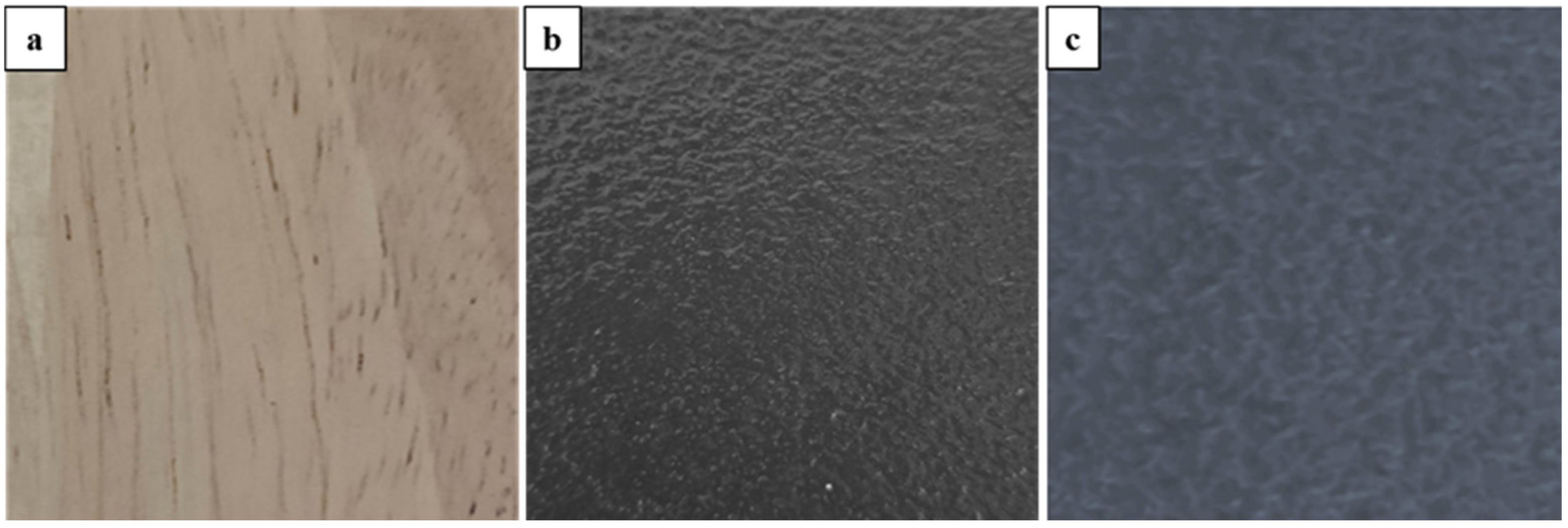
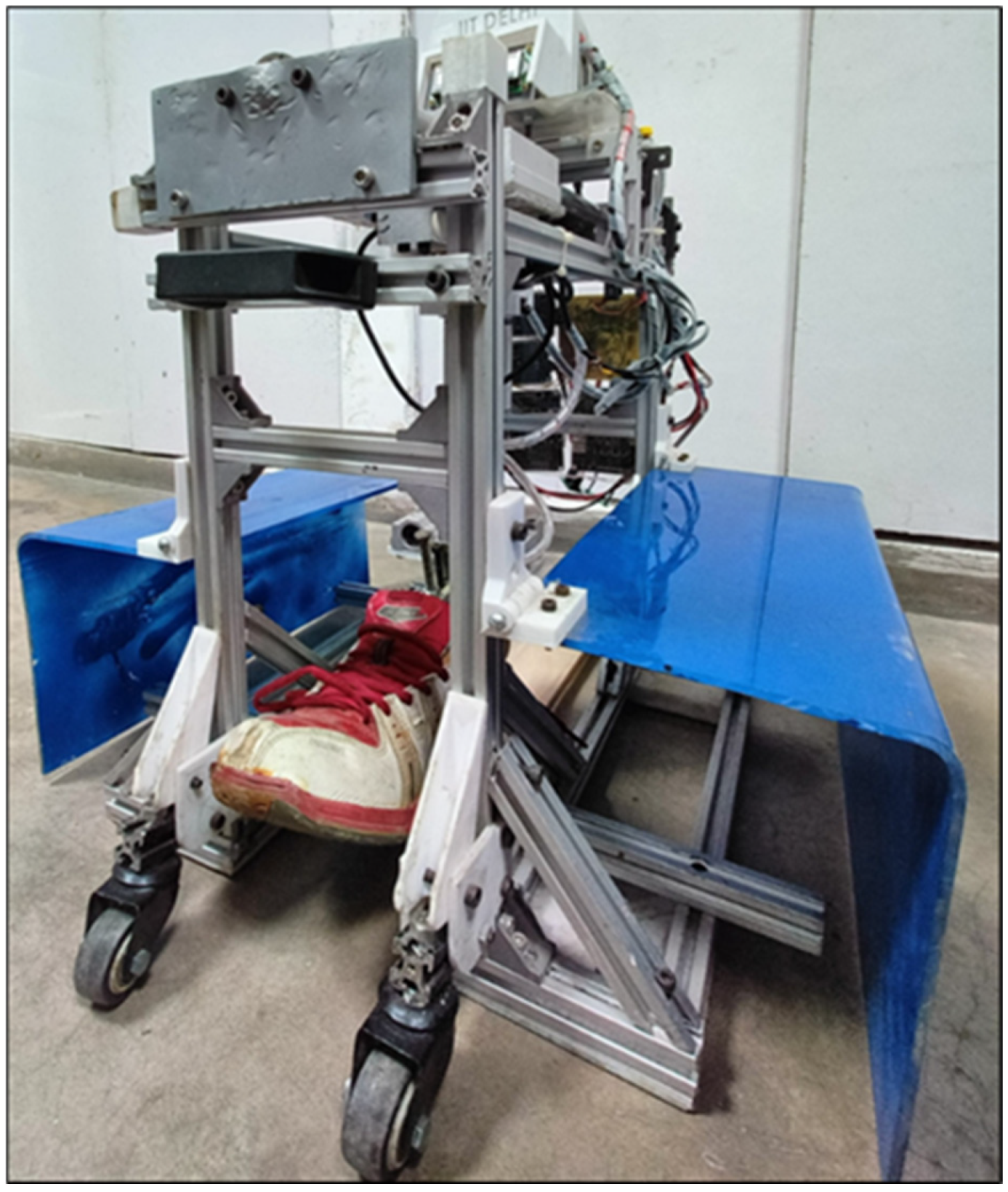
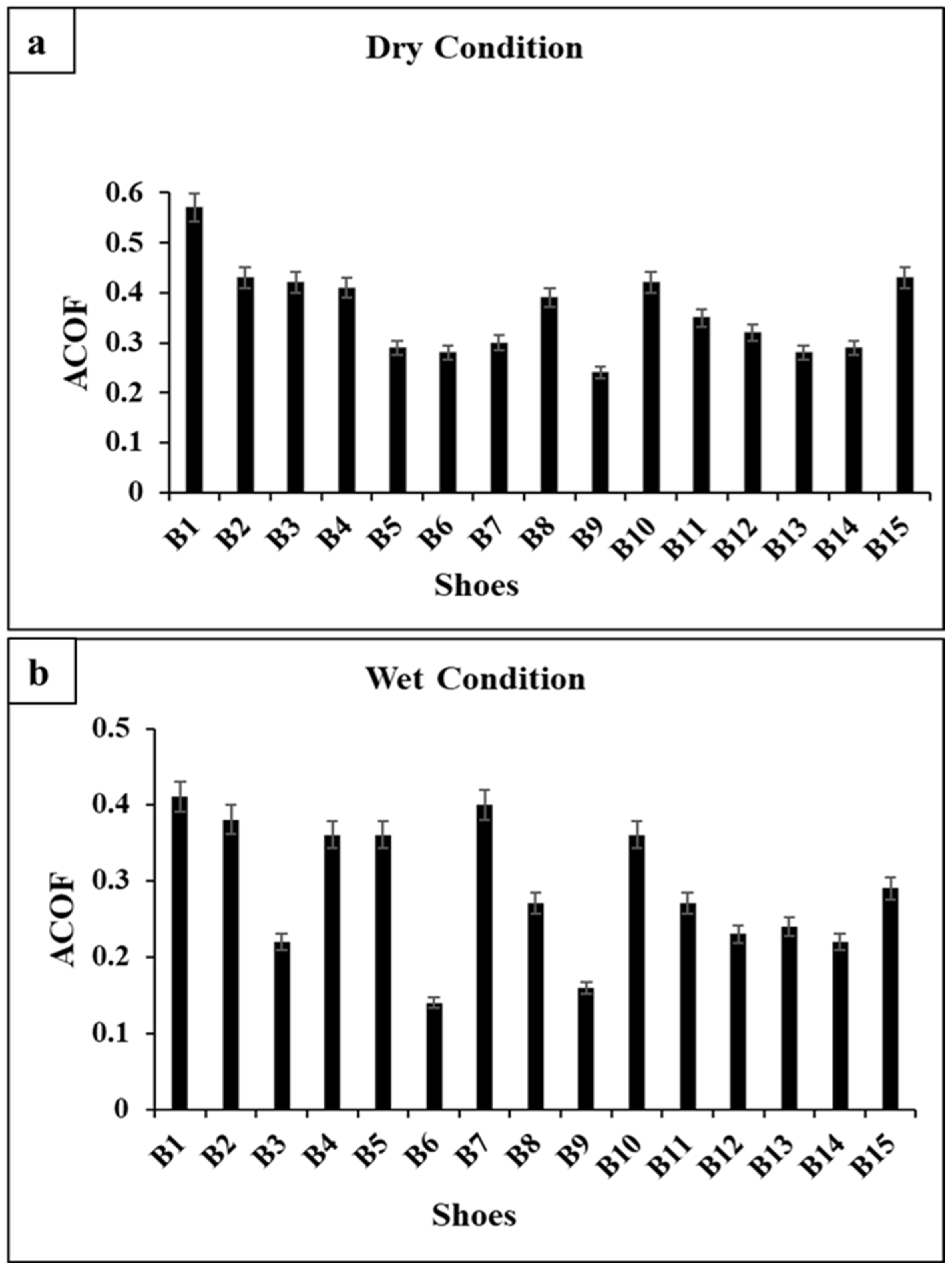
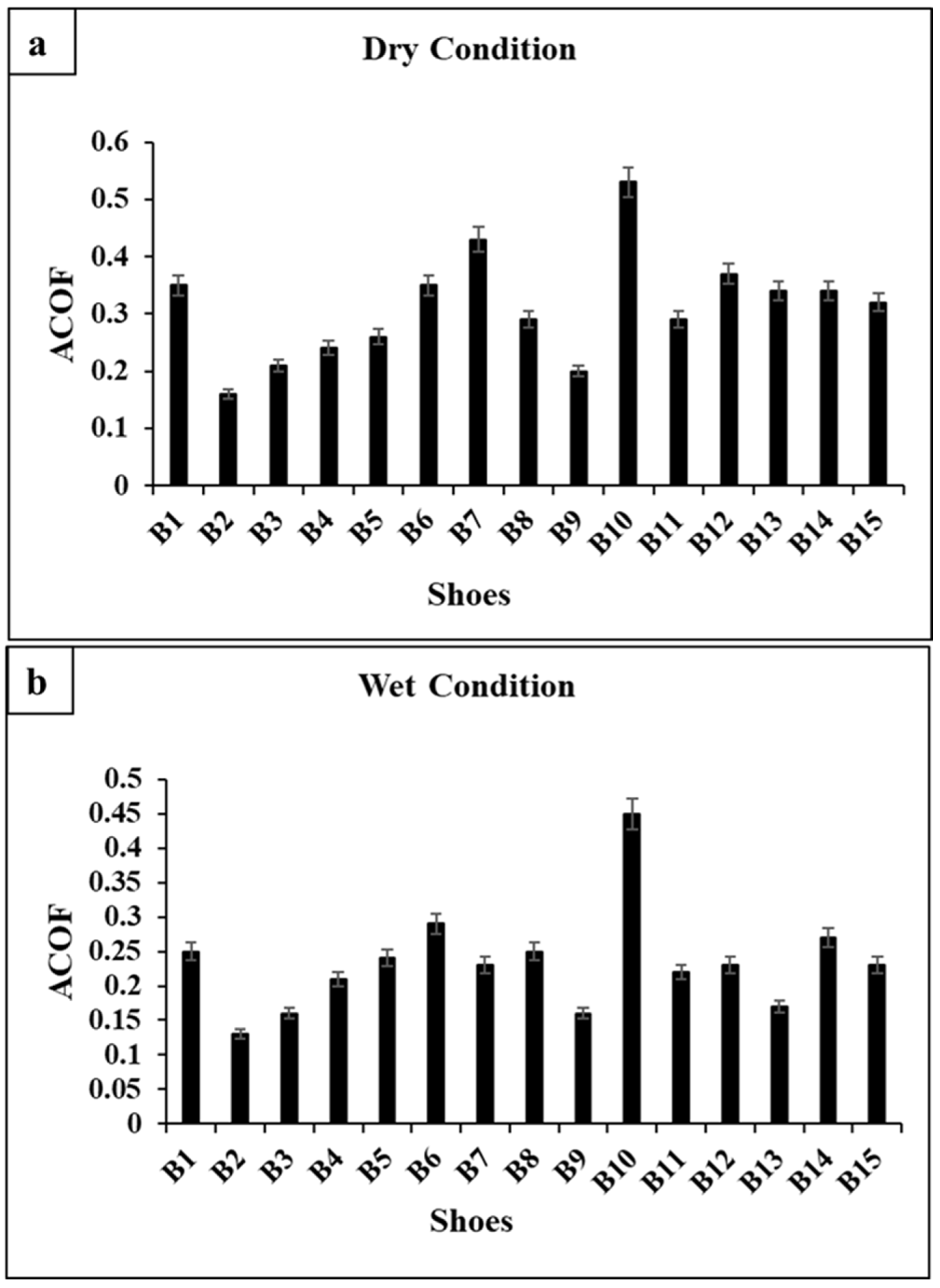
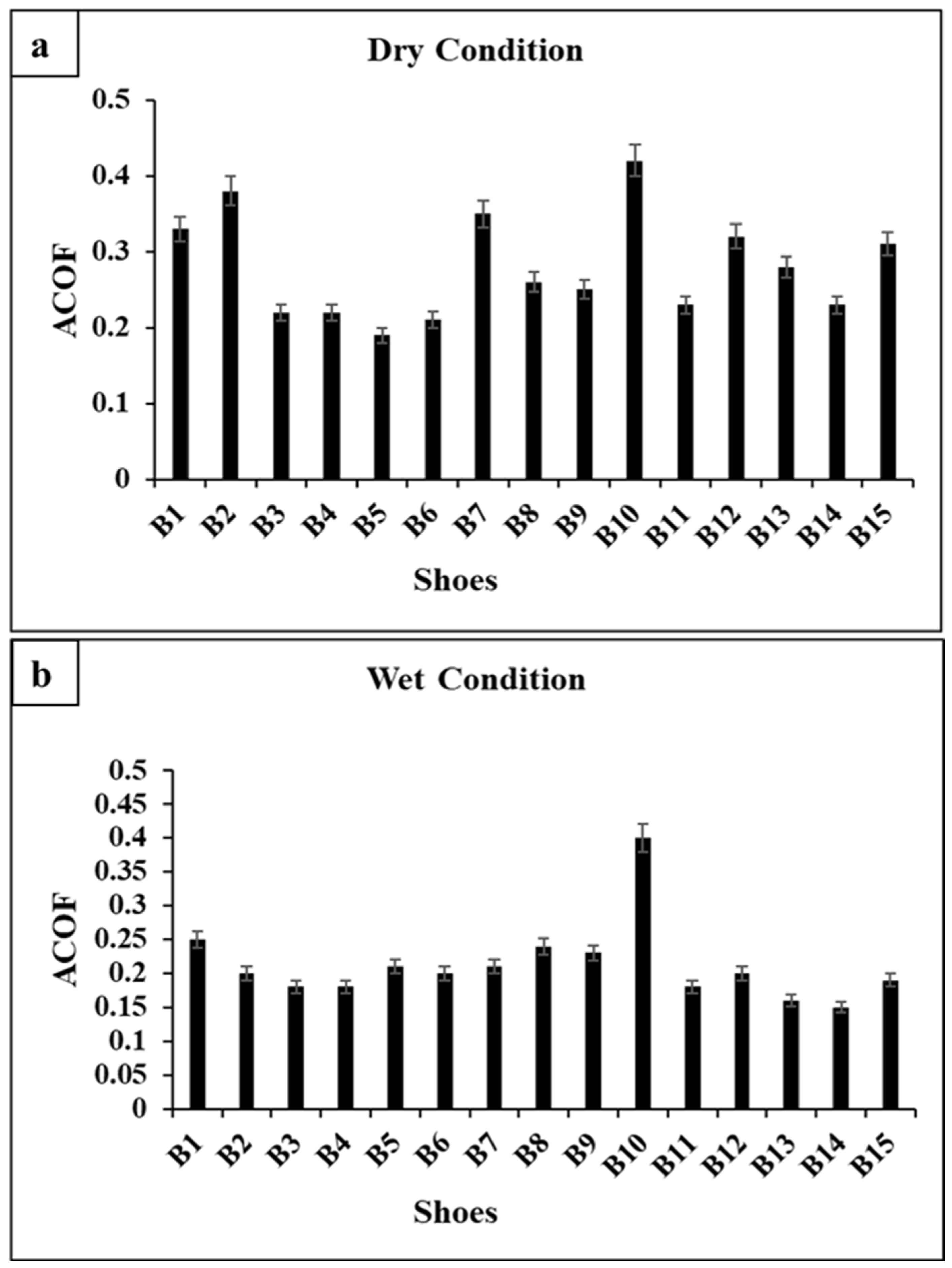
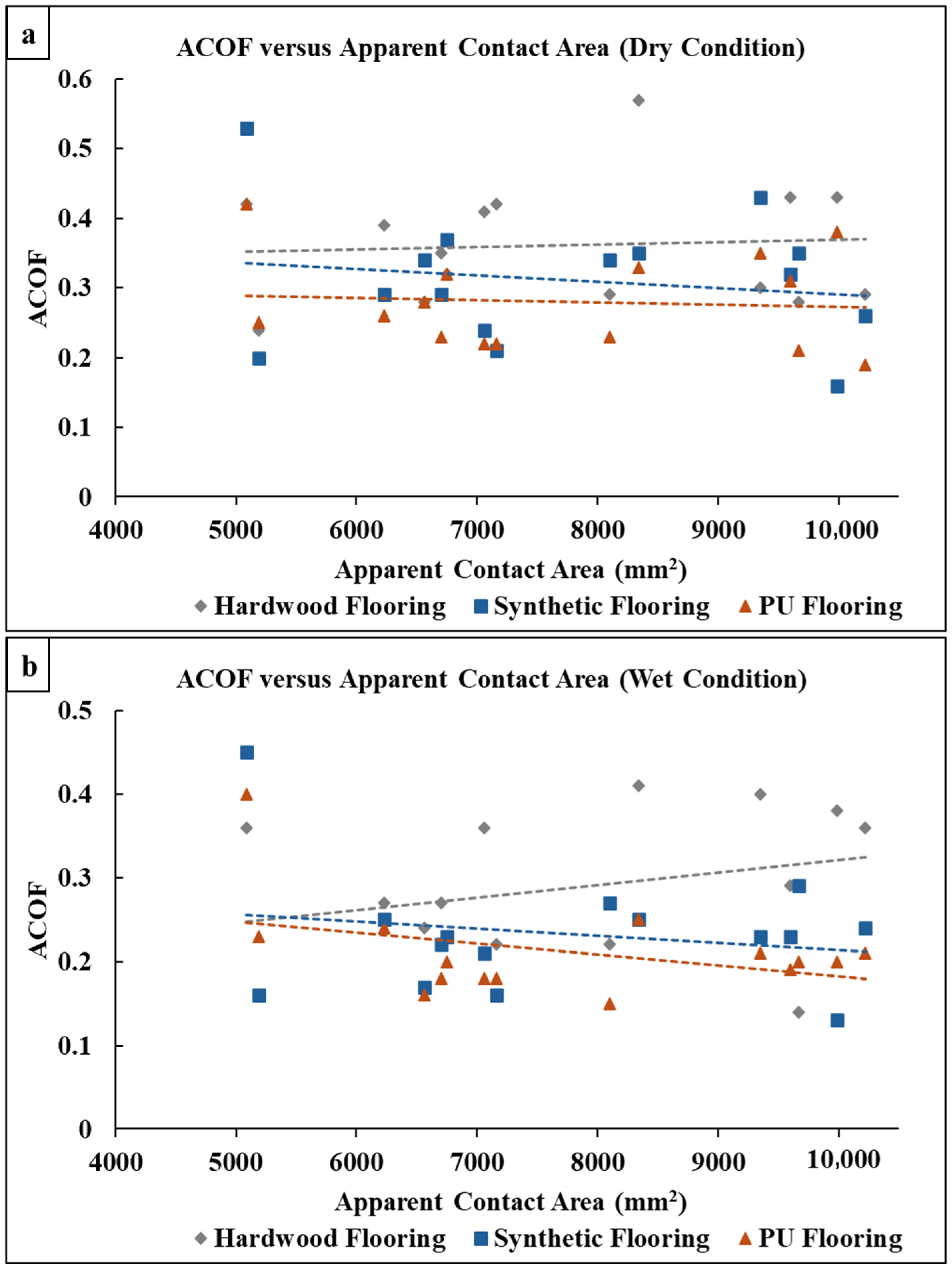
| Heel Pattern | Hardwood Flooring | Synthetic Flooring | PU Flooring | |||
|---|---|---|---|---|---|---|
| Dry Condition | Wet Condition | Dry Condition | Wet Condition | Dry Condition | Wet Condition | |
 | 0.57 | 0.41 | 0.35 | 0.25 | 0.33 | 0.25 |
 | 0.3 | 0.4 | 0.43 | 0.23 | 0.35 | 0.21 |
 | 0.42 | 0.36 | 0.53 | 0.45 | 0.42 | 0.4 |
 | 0.32 | 0.23 | 0.37 | 0.23 | 0.32 | 0.2 |
 | 0.43 | 0.29 | 0.32 | 0.23 | 0.31 | 0.19 |
Disclaimer/Publisher’s Note: The statements, opinions and data contained in all publications are solely those of the individual author(s) and contributor(s) and not of MDPI and/or the editor(s). MDPI and/or the editor(s) disclaim responsibility for any injury to people or property resulting from any ideas, methods, instructions or products referred to in the content. |
© 2025 by the authors. Licensee MDPI, Basel, Switzerland. This article is an open access article distributed under the terms and conditions of the Creative Commons Attribution (CC BY) license (https://creativecommons.org/licenses/by/4.0/).
Share and Cite
Yadav, P.; Gupta, S.; Sharma, D.; Chanda, A. Slip-Resistance Performance of Basketball Shoes Tread Patterns on Common Courts. Appl. Mech. 2025, 6, 54. https://doi.org/10.3390/applmech6030054
Yadav P, Gupta S, Sharma D, Chanda A. Slip-Resistance Performance of Basketball Shoes Tread Patterns on Common Courts. Applied Mechanics. 2025; 6(3):54. https://doi.org/10.3390/applmech6030054
Chicago/Turabian StyleYadav, Pramod, Shubham Gupta, Dishant Sharma, and Arnab Chanda. 2025. "Slip-Resistance Performance of Basketball Shoes Tread Patterns on Common Courts" Applied Mechanics 6, no. 3: 54. https://doi.org/10.3390/applmech6030054
APA StyleYadav, P., Gupta, S., Sharma, D., & Chanda, A. (2025). Slip-Resistance Performance of Basketball Shoes Tread Patterns on Common Courts. Applied Mechanics, 6(3), 54. https://doi.org/10.3390/applmech6030054







